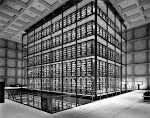The Bibliographic Framework Transition Initiative plan is available at:
http://www.loc.gov/marc/transition/news/framework-103111.html
The plan itself is a 10 p. PDF
http://www.loc.gov/marc/transition/pdf/bibframework-10312011.pdf
Bibliographic framework is intended to indicate an environment rather than a "format".
Key points
-Broad accommodation of content rules and data models. The new environment should be agnostic to cataloging rules, in recognition that different rules are used by different communities, for different aspects of a description, and for descriptions created in different eras, and that some metadata are not rule based.
-Provision for types of data that logically accompany or support bibliographic description, such as holdings, authority, classification, preservation, technical, rights, and archival metadata.
-Accommodation of textual data, linked data with URIs instead of text, and both.
-Consideration of the relationships between and recommendations for communications format tagging, record input conventions, and system storage/manipulation.
-Consideration of the needs of all sizes and types of libraries, from small public to large research.
-Continuation of maintenance of MARC until no longer necessary. It is recognized that systems and services based on the MARC 21 communications record will be an important part of the infrastructure for many years.
-Compatibility with MARC-based records.
-Provision of transformation from MARC 21 to a new bibliographic environment.
The new bibliographic framework project will be focused on the Web environment, Linked Data principles and mechanisms, and the Resource Description Framework (RDF) as a basic data model. The protocols and ideas behind Linked Data are natural exchange mechanisms for the Web that have found substantial resonance even beyond the cultural heritage sector. Likewise, it is expected that the use of RDF and other W3C (World Wide Web Consortium) developments will enable the integration of library data and other cultural heritage data on the Web for more expansive user access to information.
You all may also want to look at the report from Stanford on Linked Data at
http://www-sul.stanford.edu/about_sulair/news_and_events/Stanford_Linked_Data_Workshop_Report_FINAL.pdf
Published in October 2011, the report was compiled by Michael A. Keller, Jerry Persons, Hugh Glaser, and Mimi Calter. (60 pages, PDF)
The preliminary project timetable
The Library of Congress will develop a grant application in the next few months. The two-year grant will provide funding for the Library of Congress to organize consultative groups (national and international) and to support development and prototyping activities. Work to be done, then, more or less in 2012 and 2013 includes: developing models and scenarios for interaction within the information community, assembling and reviewing ontologies currently used or under development, developing domain ontologies for the description of resources and related data in scope, organizing prototypes and reference implementations.
Additional LC bibliographic framework transition links
Bibliographic Framework Transition Initiative Website
http://www.loc.gov/marc/transition/
Bibliographic Framework Transition Initiative Listserv
http://listserv.loc.gov/listarch/bibframe.html
Working Group on the Future of Bibliographic Control Website
http://www.loc.gov/bibliographic-future/



